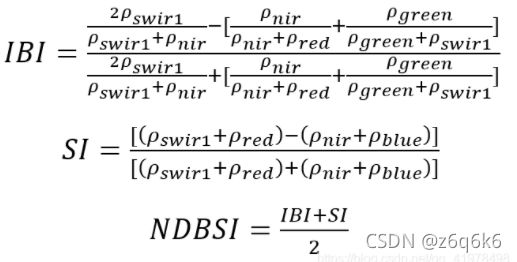GEE计算遥感生态指数(RSEI)--Landsat 8为例
目录
RSEI原理
湿度指标(Wet)
绿度指标(NDVI)
热度指标(LST)
干度指标(NDBSI)
Landsat-8波段
归一化(normalization)
主成分分析( PCA )
PCA-->RSEI
Wet、NDVI、LST、NDBSI、PCA、RSEI之间的关系
代码
运行结果
感谢
RSEI原理
RSEI是一个完全基于遥感技术,以自然因子为主的遥感生态指数(RSEI) 来对城市的生态状况进行快速监测与评价的方法,由徐涵秋.城市遥感生态指数的创建及其应用[J].生态学报,2013,33(24):7853-7862.中提出。
该指数利用主成分分析技术集成了植被指数、湿度分量、地表温度和建筑指数等 4 个评价指标,它们分别代表了绿度、湿度、热度和干度等 4 大生态要素。
湿度指标(Wet)
WET = c1 B1 + c2 B2 + c3 B3 + c4 B4 + c5 B5 + c6 B6
B1-B6 分别代表蓝波段、绿波段、红波段、近红波段、中红外波段 1、中红外波段 2;
c1~c6是传感器参数。由于传感器的类型不同,参数也相应有所不同。
其中,TM 传感器,c1 ~ c6 分 别 为 0.0315、0.2021、0.3012、0.1594、-0.6806、-0.6109;
OLI 传感器,c1 ~ c6 分别为 0.1511、 0.1973、 0.3283、 0.3407、-0.7117、 -0.4559。
Landsat 8上携带的是陆地成像仪(Operational Land Imager ,OLI)
绿度指标(NDVI)
NDVI=(NIR-Red)/(NIR+Red)
热度指标(LST)
直接计算有点麻烦,故直接采用 MODIS 的LST,利用以下公式
LST = ( LST_Day_1km + LST_Night_1km )/ 2
补充:现在才知道 Landsat 也有LST产品,且分辨率为30m,但是不改代码了,如何分辨率改为30m,下面代码的研究区太大了,会有点问题
LANDSAT/LC08/C02/T1_L2
介绍:
https://developers.google.com/earth-engine/datasets/catalog/LANDSAT_LC08_C02_T1_L2
https://developers.google.com/earth-engine/datasets/catalog/LANDSAT_LC08_C02_T1_L2
干度指标(NDBSI)
IBI 是建筑指数
SI为土壤指数
Landsat-8波段
徐涵秋使用的是Landsat-7 ETM+遥感影像,但是本文采用的是Landsat-8遥感影像为例
归一化(normalization)
先使用ee.Reducer.minMax求出该幅遥感影像的最大值和最小值
在使用unitScale(low, high)使输入值的范围[低,高]变为[0,1]
主成分分析( PCA )
PCA就是一个有损的降维算法。
具体的请看代码的英文注释,不敢讲,请自行百度理解。
推荐
GEE主成分分析全流程Google earth engine如何进行主成分分析![]() https://mp.weixin.qq.com/s/spi10OeHDRo6VpIrrpvYHA
https://mp.weixin.qq.com/s/spi10OeHDRo6VpIrrpvYHA
PCA-->RSEI
Wet、NDVI、LST、NDBSI、PCA、RSEI之间的关系
在 PC1 中,代表绿度的 NDVI 和代表湿度的 Wet 指标呈正值,说明它们对生态系统起 正面的贡献,而代表热度和干度的 LST、NDBSI 则呈负值,这与实际情况相符。
综合来看,以 NDVI 为代表的植被和以 NDBSI 为代表的建筑用地对城市生态的影响力最大,且 NDVI 大 于 NDBSI。NDBSI 所代表的建筑不透水面对城市地表温度LST具有正相关关系
RSEI 即为所建的遥感生态指数,其值介于[0,1]之间。RSEI 值越接近 1,生态越好,反之,生态越差。
好好品一下这个话:为使 PC1 大的数值代表好的生态条件,可进一步用 1 减 去 PC1,获得初始的生态指数 RSEI0
PC1的值大,不代表生态好,PC1小的值,也不代表生态不好。只有RSEI0 = 1 - PC1才能代表生态
代码
// roi和table不是一个geometry,运行的话,注意一下
var roi = table.geometry().bounds()
Map.centerObject(roi, 5);
function remove_water(img) {
var year = img.get('year')
// jrc_year: JRC Yearly Water Classification History, v1.3
var Mask = jrc_year.filterMetadata('year', 'equals', year)
.filterBounds(roi)
.first()
.select('waterClass')
.reproject('EPSG:4326',null,1000)
// 掩膜掉大片永久水体
.eq(3)
// 此时Mask中value值有1 , 0 , masked,把masked转化为 0
Mask = Mask.unmask(0).not()
return img.updateMask(Mask)
}
function removeCloud(image){
var qa = image.select('BQA')
var cloudMask = qa.bitwiseAnd(1 << 4).eq(0)
var cloudShadowMask = qa.bitwiseAnd(1 << 8).eq(0)
var valid = cloudMask.and(cloudShadowMask)
return image.updateMask(valid)
}
var L8 = ee.ImageCollection('LANDSAT/LC08/C01/T1_TOA')
.filterBounds(roi)
.filterDate('2014-01-01', '2019-12-31')
.filterMetadata('CLOUD_COVER', 'less_than',50)
.map(function(image){
return image.set('year', ee.Image(image).date().get('year'))
})
.map(removeCloud)
var L8imgList = ee.List([])
for(var a = 2014; a < 2020; a++){
var img = L8.filterMetadata('year', 'equals', a).median().clip(roi)
var L8img = img.set('year', a)
L8imgList = L8imgList.add(L8img)
}
var L8imgCol = ee.ImageCollection(L8imgList)
.map(function(img){
return img.clip(roi)
})
.map(remove_water)
L8imgCol = L8imgCol.map(function(img){
// Wet
var Wet = img.expression('B*(0.1509) + G*(0.1973) + R*(0.3279) + NIR*(0.3406) + SWIR1*(-0.7112) + SWIR2*(-0.4572)',{
'B': img.select(['B2']),
'G': img.select(['B3']),
'R': img.select(['B4']),
'NIR': img.select(['B5']),
'SWIR1': img.select(['B6']),
'SWIR2': img.select(['B7'])
})
img = img.addBands(Wet.rename('WET'))
// NDVI
var ndvi = img.normalizedDifference(['B5', 'B4']);
img = img.addBands(ndvi.rename('NDVI'))
// lst 直接采用MODIS产品,表示看不懂 LST 公式
var lst = ee.ImageCollection('MODIS/006/MOD11A1').map(function(img){
return img.clip(roi)
})
.filterDate('2014-01-01', '2019-12-31')
var year = img.get('year')
lst=lst.filterDate(ee.String(year).cat('-01-01'),ee.String(year).cat('-12-31')).select(['LST_Day_1km', 'LST_Night_1km']);
// reproject主要是为了确保分辨率为1000
var img_mean=lst.mean().reproject('EPSG:4326',null,1000);
//print(img_mean.projection().nominalScale())
img_mean = img_mean.expression('((Day + Night) / 2)',{
'Day': img_mean.select(['LST_Day_1km']),
'Night': img_mean.select(['LST_Night_1km']),
})
img = img.addBands(img_mean.rename('LST'))
// ndbsi = ( ibi + si ) / 2
var ibi = img.expression('(2 * SWIR1 / (SWIR1 + NIR) - (NIR / (NIR + RED) + GREEN / (GREEN + SWIR1))) / (2 * SWIR1 / (SWIR1 + NIR) + (NIR / (NIR + RED) + GREEN / (GREEN + SWIR1)))', {
'SWIR1': img.select('B6'),
'NIR': img.select('B5'),
'RED': img.select('B4'),
'GREEN': img.select('B3')
})
var si = img.expression('((SWIR1 + RED) - (NIR + BLUE)) / ((SWIR1 + RED) + (NIR + BLUE))', {
'SWIR1': img.select('B6'),
'NIR': img.select('B5'),
'RED': img.select('B4'),
'BLUE': img.select('B2')
})
var ndbsi = (ibi.add(si)).divide(2)
return img.addBands(ndbsi.rename('NDBSI'))
})
var bandNames = ['NDVI', "NDBSI", "WET", "LST"]
L8imgCol = L8imgCol.select(bandNames)
// 归一化
var img_normalize = function(img){
var minMax = img.reduceRegion({
reducer:ee.Reducer.minMax(),
geometry: roi,
scale: 1000,
maxPixels: 10e13,
})
var year = img.get('year')
var normalize = ee.ImageCollection.fromImages(
img.bandNames().map(function(name){
name = ee.String(name);
var band = img.select(name);
return band.unitScale(ee.Number(minMax.get(name.cat('_min'))), ee.Number(minMax.get(name.cat('_max'))));
})
).toBands().rename(img.bandNames()).set('year', year);
return normalize;
}
var imgNorcol = L8imgCol.map(img_normalize);
// 主成分
var pca = function(img){
var bandNames = img.bandNames();
var region = roi;
var year = img.get('year')
// Mean center the data to enable a faster covariance reducer
// and an SD stretch of the principal components.
var meanDict = img.reduceRegion({
reducer: ee.Reducer.mean(),
geometry: region,
scale: 1000,
maxPixels: 10e13
});
var means = ee.Image.constant(meanDict.values(bandNames));
var centered = img.subtract(means).set('year', year);
// This helper function returns a list of new band names.
var getNewBandNames = function(prefix, bandNames){
var seq = ee.List.sequence(1, 4);
//var seq = ee.List.sequence(1, bandNames.length());
return seq.map(function(n){
return ee.String(prefix).cat(ee.Number(n).int());
});
};
// This function accepts mean centered imagery, a scale and
// a region in which to perform the analysis. It returns the
// Principal Components (PC) in the region as a new image.
var getPrincipalComponents = function(centered, scale, region){
var year = centered.get('year')
var arrays = centered.toArray();
// Compute the covariance of the bands within the region.
var covar = arrays.reduceRegion({
reducer: ee.Reducer.centeredCovariance(),
geometry: region,
scale: scale,
bestEffort:true,
maxPixels: 10e13
});
// Get the 'array' covariance result and cast to an array.
// This represents the band-to-band covariance within the region.
var covarArray = ee.Array(covar.get('array'));
// Perform an eigen analysis and slice apart the values and vectors.
var eigens = covarArray.eigen();
// This is a P-length vector of Eigenvalues.
var eigenValues = eigens.slice(1, 0, 1);
// This is a PxP matrix with eigenvectors in rows.
var eigenVectors = eigens.slice(1, 1);
// Convert the array image to 2D arrays for matrix computations.
var arrayImage = arrays.toArray(1)
// Left multiply the image array by the matrix of eigenvectors.
var principalComponents = ee.Image(eigenVectors).matrixMultiply(arrayImage);
// Turn the square roots of the Eigenvalues into a P-band image.
var sdImage = ee.Image(eigenValues.sqrt())
.arrayProject([0]).arrayFlatten([getNewBandNames('SD',bandNames)]);
// Turn the PCs into a P-band image, normalized by SD.
return principalComponents
// Throw out an an unneeded dimension, [[]] -> [].
.arrayProject([0])
// Make the one band array image a multi-band image, [] -> image.
.arrayFlatten([getNewBandNames('PC', bandNames)])
// Normalize the PCs by their SDs.
.divide(sdImage)
.set('year', year);
}
// Get the PCs at the specified scale and in the specified region
img = getPrincipalComponents(centered, 1000, region);
return img;
};
var PCA_imgcol = imgNorcol.map(pca)
Map.addLayer(PCA_imgcol.first(), {"bands":["PC1"]}, 'pc1')
// 利用PC1,计算RSEI,并归一化
var RSEI_imgcol = PCA_imgcol.map(function(img){
img = img.addBands(ee.Image(1).rename('constant'))
var rsei = img.expression('constant - pc1' , {
constant: img.select('constant'),
pc1: img.select('PC1')
})
rsei = img_normalize(rsei)
return img.addBands(rsei.rename('rsei'))
})
print(RSEI_imgcol)
var visParam = {
palette: 'FFFFFF, CE7E45, DF923D, F1B555, FCD163, 99B718, 74A901, 66A000, 529400,' +
'3E8601, 207401, 056201, 004C00, 023B01, 012E01, 011D01, 011301'
};
Map.addLayer(RSEI_imgcol.first().select('rsei'), visParam, 'rsei')
Map.addLayer(table, null, 'river_buffer')
//var Foo = require('users/2210902141/RSEI:downloadModules.js');
//Foo.foo(rsei_imgcol.first(), roi);运行结果
感谢
遥感生态指数(RSEI)——四个指数的计算_系六九69的博客-CSDN博客_rsei
利用GEE逐年计算1990-2020年秦岭北麓遥感生态指数(RSEI)二 - 知乎![]() https://zhuanlan.zhihu.com/p/347934313
https://zhuanlan.zhihu.com/p/347934313




